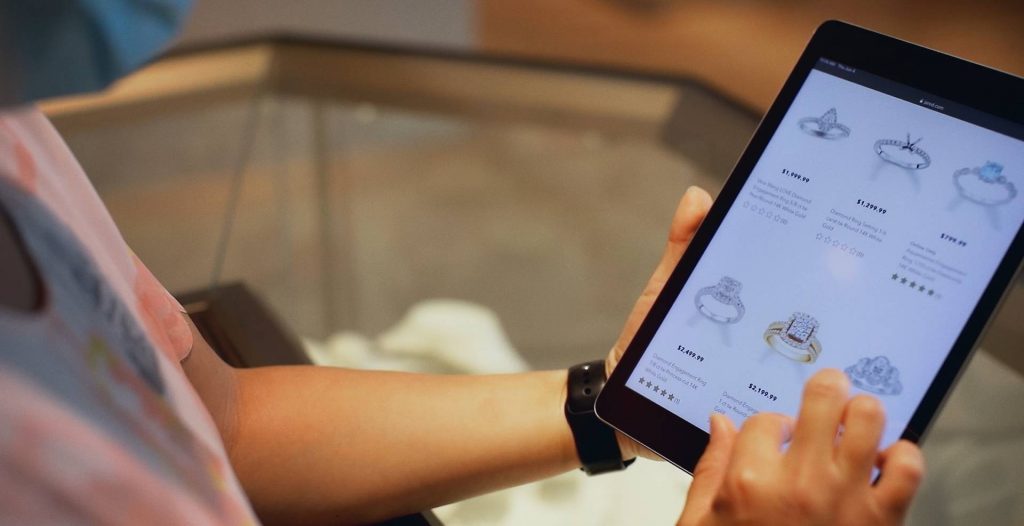During an analyst call earlier this year, North American jewellery-conglomerate, Signet Jewelers, said that 80% of the company’s sales take place inside its 2,800+ physical stores, however 65% of customers visit at least one of the company’s “digital sites” during their shopping journey.
Customers researching online and then buying in-store, is an example of what the downstream refers to “omni-channel” retail, essentially an integration of the digital and physical shopping experience. Signet management has described this approach as a way to “stay close to our customers (at all times),” which became especially relevant during the pandemic-related lockdowns in 2020 and 2021.
During the company’s current fiscal year, which ends January 2023, Signet said it plans to spend some $250 million (of the $900 million in operating income it generated last year) on enhancing its “data driven” omni-channel strategies – including augmented virtual customer service systems and other digital as well as in person “innovative and personalised experience” initiatives for customers.
It’s not just Signet, most of the major jewellers around the world are embracing similar strategies. Last year, China’s Chow Tai Fook told Paul Zimnisky via a direct correspondence: “the outbreak of Covid-19 speeded up our omni-channel development…digital empowerment will be our key focus in coming years, no matter what, we shall continue to invest in both e-commerce and O2O,” i.e. online-to-offline.
High-end commercial real-estate developer, Westfield, recently provided a glimpse of how omni-channel strategies could drive retail strategies in the coming years.
In a 2021 client report titled “How We Shop the Next Decade,” Westfield predicted that by 2025 their “retailers will allocate more square footage to experience than product,” as ‘buying online picking up in store’ becomes more popular – referring to the concept as “upside-down retail.” The trend can be seen as a way to combine the “experience economy” with traditional retail.
For example, LED wall and virtual production technology can be used to create engaging “retail theatre” within stores. Further, digital personalisation tools within stores can allow customers to virtually try, test and customise merchandise while immersing with the brand through visuals and sound.
The Westfield report concludes: “shoppers want to escape from the day-to-day when they shop, which is why they get particularly excited about the idea of escapist experiences” – retailers need to embrace this.
Fittingly, as traditional brick-and-mortars digitally integrate, e-commerce companies are integrating via physical-store expansion. In the jewellery industry in particular, leading online diamond retailers are doing just this. Both Blue Nile and James Allen have opened showrooms in recent years. Blue Nile is targeting up to 100 brick-and-mortar “webrooms” by mid-decade.
In late 2018, James Allen opened a concept store in Washington D.C., employing many of the in-store technologies mentioned above. Subsequently, James Allen parent, Signet, has opened multiple James Allen/Jared combination stores – the latter banner being Signet’s high-end bridal-focused destination. The stores include a coffee bar in a “modern, warm, and relaxed” environment, in which sales associates and customers interact side-by-side – similar to the Apple Store set-up.
Just this month, Brilliant Earth, the US-based “digitally native” online diamond retailer that went public last year, said it continues to successfully open physical showrooms, primary in key US regions, bringing the company’s total “store-count” to 18 as of early May. During an analyst call, management noted that the showrooms have “outperformed initial expectations,” leading to a higher customer repeat purchase rate than online.
—
Paul Zimnisky, CFA is an independent diamond industry analyst and consultant based in the New York metro area. For regular in-depth analysis of the diamond industry please consider subscribing to his State of the Diamond Market, a leading monthly industry report; an index of previous editions can be found here. Also, listen to the Paul Zimnisky Diamond Analytics Podcast on iTunes or Spotify. Paul is a graduate of the University of Maryland’s Robert H. Smith School of Business with a B.S. in finance and he is a CFA charterholder. He can be reached at paul@paulzimnisky.com and followed on Twitter @paulzimnisky.
Disclosure: At the time of writing Paul Zimnisky held a long position in Lucara Diamond Corp, Star Diamond Corp, North Arrow Minerals Inc, Brilliant Earth Group and Barrick Gold Corp. Please read full disclosure at www.paulzimnisky.com.


